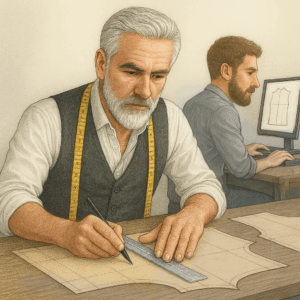
Block: what it is, what it’s for, and how it is classified
The block is a fundamental template in fashion design, tailoring, and industrial garment construction. It outlines the basic shapes of the human body without any stylistic elements, decoration, or embellishment. Built from precise body measurements, it reflects a neutral, anatomically accurate structure that fits closely to the body.
As a result, the block serves as the foundation for developing a wide variety of garments, from T-shirts and jackets to corsets and dresses. It usually does not include design ease, although it may incorporate technical ease to ensure proper comfort and movement.
What is a block in patternmaking?
The block is an essential template in fashion design, tailoring, and industrial garment construction. It represents the fundamental shapes of the human body without any added style, decoration, or embellishment. It is built from precise body measurements and reflects a neutral, anatomically accurate structure that fits closely to the body.
The block serves as the starting point for developing all kinds of garments, from T-shirts to jackets, corsets, or dresses. It usually does not include design ease, but it may incorporate technical ease, which is necessary for allowing body movement and comfort.
What is a block used for?
- A block allows garments to fit the body with anatomical precision.
- Furthermore, it provides a reliable base for transforming the original shape into different styles or models.
- It also acts as a reference for grading—that is, the creation of various sizes from a single pattern.
- Finally, the block offers a solid foundation for applying stylistic modifications with full technical control.
Blocks are divided into two main groups:
- Blocks for upper garments (bodice, jacket, shirt, etc.)
- Blocks for lower garments (trousers, skirts, etc.)
What is technical ease?
Technical ease refers to the minimal extra space added to a block to allow the body to move freely, breathe, and feel comfortable in the finished garment. Unlike design ease, which serves an aesthetic purpose, technical ease is a functional requirement.
Key characteristics:
- It is minimal, calculated, and precisely controlled.
- It varies depending on garment type and fabric. For example, rigid fabrics require more ease than stretchy ones.
- It focuses on mobility-critical zones: chest, shoulders, waist, hips, armholes, and crotch.
Example:
A block without ease fits like a second skin. However, by introducing technical ease at the chest, the wearer can breathe and move their arms freely without the fabric pulling or tightening.
Important difference:
In short, technical ease is essential for comfort and functionality. In contrast, design ease is optional and depends on creative intent.
Types of upper-body patterns
There are two main types of upper-body base patterns, depending on the garment’s structure and intended style.
1. Two-piece basic pattern that does not follow the sternum inclination
This pattern is designed for loose garments or stretch fabrics, such as T-shirts, sweatshirts, or shirts. It does not take into account the inclination of the sternum and may include sleeves. Its structure is based on a two-piece body: front and back.
See: Drafting the Two-Piece Body Pattern and One-Piece Sleeve
2. Two- or three-piece basic pattern that follows the sternum inclination
This block takes the sternum tilt into account and shapes the figure using darts. It is used for more tailored garments such as corsets, waistcoats, dresses, blazers, or coats. Its structure includes two or three pieces and may also feature sleeves.
Depending on the amount of ease provided, we distinguish:
- Base bodice pattern – for fitted garments.
- Base jacket pattern – for voluminous or structured garments.
